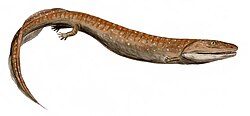| Jakubsonia Temporal range: Late Devonian | |
|---|---|
| Scientific classification | |
| Domain: | Eukaryota |
| Kingdom: | Animalia |
| Phylum: | Chordata |
| Clade: | Sarcopterygii |
| Clade: | Tetrapodomorpha |
| Clade: | Stegocephali |
| Genus: | † Jakubsonia Lebedev, 2004 |
| Type species | |
| †J. livnensis Lebedev, 2004 | |
Jakubsonia is an extinct genus of early tetrapod from the Late Devonian of Russia. The type species, Jakubsonia livnensis, was described and named in 2004. [1]





